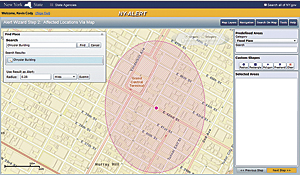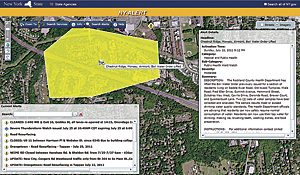How Do You Warn 19 Million People at the Drop of a Hat?
New York State Department of Homeland Security and Emergency Services Alerts Its Citizens with GIS
By James W. Clohessy and Patrick J. Cerra, Buffalo Computer Graphics
Highlights
- With ArcGIS for Server, NY-ALERT can choose how it defines alert areas.
- Police and fire agencies use GIS to deliver special instructions to emergency responders.
- Sixty-three state universities use the system to alert students.
New York State Department of Homeland Security and Emergency Services (NYS-DHSES) is tasked with protecting the lives and property of the public of New York from threats posed by both natural and human-made events. To succeed in its mission, NYS-DHSES identified the need for a technology system that could push up-to-date information and instruction out to the public. This technology system would have to distribute public information swiftly to maximize the ability for at-risk civilians to protect themselves. Furthermore, it would need an encompassing reach via multiple communication channels to notify as many civilians as possible.

Alert creators can create custom alerts through the Notifier's map interface using drawing tools, predefined boundaries, and buffered features.
With a population of more than 19 million, New York is the third most populous state in the United States, so providing emergency information to its citizens quickly is an extraordinary task. NYS-DHSES would require a large, scalable infrastructure to store and search civilian information, along with a telecommunications system capable of reliably delivering emergency messages to a large population. The system would have to utilize the latest communication technologies, as well as integrate established methods of delivery. Eleven communication channels were designated for use, including phone, Enhanced 911, short message service, multimedia messaging service, e-mail, pagers, fax, emergency broadcast systems, Twitter, Common Alerting Protocol messaging, and GeoRSS.
To help provide a solution to these challenges, NYS-DHSES contracted with Buffalo Computer Graphics, Inc., an Esri Partner in Blasdell, New York. The company had an established record of accomplishment with New York state as a custom software engineering firm and subject matter expert in public safety, GIS, and web application development. The company had also provided NYS-DHSES with DisasterLAN, an ArcGIS for Server software-enabled disaster management solution.
In 2006, Buffalo Computer Graphics provided New York state with the NY-ALERT mass notification system (www.nyalert.gov). Initially, the system notified New York citizens of both routine and emergency incidents based on municipal boundaries. However, in the event of a localized incident, such as a fire or chemical spill in a dense urban area like New York City, this method of defining the alert areas would not be ideal. NY-ALERT needed to find a way to mitigate the potential for inefficient overalerting that could cause panic in nearby unaffected populations.
The system needed to be upgraded, allowing each civilian to be located by means of a set of location points, such as home and workplace. Administrators at NYS-DHSES could then be given tools to define the exact areas where an alert needed to be sent. Buffalo Computer Graphics evaluated a wide range of GIS technologies in an attempt to find the most scalable and reliable solution that provided the features required to complete the task. The company selected ArcGIS for Server as the preferred technology platform due to its analytic feature sets.
The current NY-ALERT system leverages the capabilities of ArcGIS for Server so that administrators can define an alert area in a variety of ways, including freehand drawing, loading stored polygons such as floodplains, editing existing polygons, and issuing buffered radius alerts using a custom web interface. Automated geographic alert notifications are sent by utilizing weather feeds from the National Weather Service, earthquake feeds from the US Geological Survey, and information from other providers that use the Common Alerting Protocol standard. Furthermore, by leveraging the Flex and Silverlight APIs, scalable public-facing mapping interfaces are provided. These publicly available GIS tools (including a statewide notification map and an address confirmation tool) grant New Yorkers a rich, map-based experience from within NY-ALERT.
Thanks to its scalability and power, the NY-ALERT system has expanded beyond simply providing life safety alerts. The system now provides traffic, sex offender relocation, power outage, AMBER, and consumer safety alerts, as well as statewide press releases. Moreover, 63 state universities now use the system to provide notifications or emergency alerts to their enrolled students. Several public and private organizations, including police and fire agencies, utilize NY-ALERT's private group notification tools to deliver special instructions to emergency responders about disasters.
The US Virgin Islands (www.vialert.gov) and Rochester, Minnesota, now leverage the same massive scale infrastructure and features provided by NY-ALERT.
Mobile App
With its newest release, NY-ALERT will expand into the free mobile app market with an iPhone application called iAlertz. This app adds a channel through which NY-ALERT can disseminate alert notifications directly to smartphone users. The app also has an on-the-go local emergency contact information lookup service, which provides accurate contact information based on the user's current location. Administrators can also use this application for sending an alert notification or information update directly from the field.
"With these new services," says Kevin Ross, assistant director of technology at NYS-DHSES, "we are undoubtedly making the people of New York state safer and better informed by leveraging the state of the art in technology."
About the Authors
James W. Clohessy has worked for Buffalo Computer Graphics on the design, development, implementation, and support of the GIS components within NY-ALERT, DisasterLAN, and custom GIS projects. Patrick J. Cerra, also with Buffalo Computer Graphics, is a senior quality assurance specialist for the DisasterLAN and NY-ALERT software systems, where he is responsible for software patch management, QA testing, user training, and customer support.
For more information, contact Kevin Ross, assistant director of technology, Division of Homeland Security and Emergency Services (e-mail: kross@dhses.ny.gov), or James Clohessy, Buffalo Computer Graphics (e-mail: jclohessy@buffalocomputergraphics.com).
